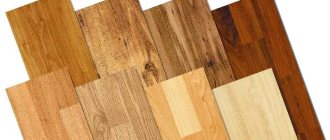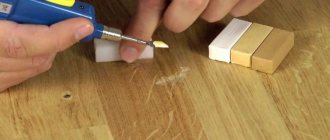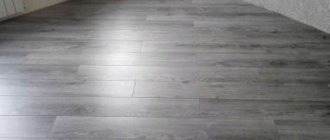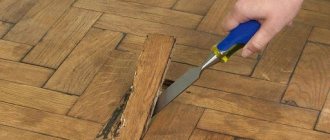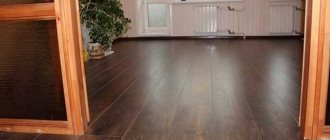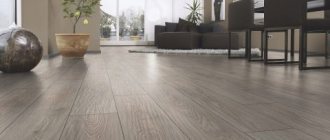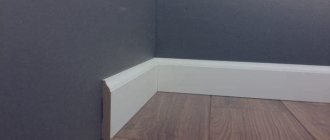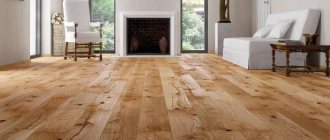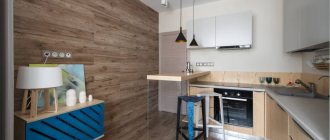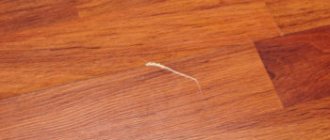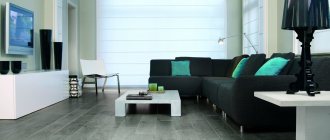Laminate is considered a practical, stylish floor covering. The best underlay for laminate flooring is a guarantee of durability and beautiful appearance of a modern coating. The underlying non-woven layer smoothes out unevenness of the base, does not allow moisture and loud sounds to pass through, and retains heat. If you cannot determine which laminate underlay will best perform its functions, we suggest that you familiarize yourself with the samples presented in the rating of the best materials. The top 14 included underlays of various thicknesses for laying on wooden and concrete floors.
Types of underlays for laminate
The modern construction market offers a wide range of underlayment materials, differing in the types of raw materials, release form (sheet, roll), origin (artificial, natural) and other characteristics. To understand which substrate is best for laminate under specific operating conditions, you need to familiarize yourself with the following factors:
- Features of the apartment.
- Substrate thickness.
- Installation difficulty level.
- The cost of the selected building material.
- Declared service life.
- Environmentally friendly material.
- Resistance against aggressive environments, fungi, rodents, harmful microorganisms, etc.
In the rating review you will learn not only about popular samples, here we will talk about materials developed using innovative technologies.
Which underlay for laminate flooring is best to buy?
You need to approach the choice of a substrate for a laminate as seriously as the laminate itself. This determines how long and how well the flooring will serve. Familiarity with the recommended brands will help determine which option is right for a particular buyer.
- Granorte - a cork model under laminate will make any home warm and cozy. If you are satisfied with the high price of a branded manufacturer;
- JPS-Cork - the standard quality of products from a well-known Portuguese company is suitable for premises where the most expensive and vulnerable live - children and the elderly;
- Steico Underfloor - German material has unique soundproofing features. Those with noisy neighbors and sound studios should take this into account;
- Izoplaat 5.5mm is a coniferous substrate that is guaranteed to last for more than half a century;
- Penolin is not inferior in quality to the best analogues, but will provide an opportunity to save material resources;
- Tuplex is a substrate created for those who decide to install a heated floor system;
- Bonkeel Smart is suitable not only for heated floors, but also for cold unheated rooms.
So, a cork, pine or polymer substrate for the laminate has been selected. Now it’s important to lay it out correctly. Otherwise, it will not serve as long and efficiently as planned. Therefore, it is better to entrust the installation to specialists.
Which underlay for laminate flooring is best to choose?
When choosing the most suitable underlayment for a floor covering in specific conditions, it is necessary to take into account certain factors:
- If your apartment is located on the ground floor, it is better to buy a laminate underlay with increased thermal insulation properties.
- When arranging children's rooms, it is recommended to give preference to materials that provide sufficient insulation from noise.
- In rooms located above bathrooms and other rooms with high humidity, it is best to use materials that do not allow moisture to pass through as a substrate.
It is up to the owner to decide which underlay for laminate flooring is best installed in your apartment. Before purchasing, we advise you to familiarize yourself with the technical and operational characteristics of the selected option, user reviews, and listen to the recommendations of experienced professionals.
Rating of laminate substrates
Regardless of the materials chosen, the floor covering should be “set it and forget it.” This means that not only the laminate, but also the substrate under it must be of high quality. Choosing the wrong material will cause a lot of trouble and will also significantly shorten the lifespan of the floor covering itself. Selecting the best options, the TOP 12 included substrates that turned out to be leaders in the following characteristics:
- Thickness;
- Thermal insulation;
- Soundproofing;
- Moisture resistance;
- What base is it mounted on?
- Shock absorption capabilities;
- Air exchange level;
- Counteracting the development of pathogenic microorganisms;
- Lifetime;
- Manufacturer.
Laminate underlays are sold in rolls or rectangular blocks. To ensure that laminate flooring retains its original appearance for as long as possible, it is important to choose a product with insulating properties.
The best polyurethane foams
Leveling the floor under the laminate with your own hands
The most common bases are concrete and plank bases; each of them requires a special approach to the leveling process.
How to lay laminate flooring on an uneven concrete floor
The material used to level the concrete floor under the laminate can be a cement screed, a self-leveling mixture or expanded clay - if a dry screed is used. As a result of leveling, you should obtain a strong, smooth surface with minor irregularities, no more than 3 millimeters.
Checking the evenness of the surface
The subfloor needs to be cleaned, waterproofed, for example, by spreading a thick plastic film, after which the screed is poured. Installation work with laminate begins when the screed has completely hardened.
Before laying the covering, you must ensure that the concrete base is completely dry. To do this, cover the floor with cellophane overnight or simply place the jar bottom up. If condensation has formed in the morning, then you still need to wait until the screed is completely dry.
How to check the levelness of the floor before laying laminate?
The evenness of the base under the laminated coating is checked by applying a long level to the surface, and differences in the height of the base plane are revealed.
We carefully inspect the surface of the base: are there any cracks, cavities and bumps that can reduce the quality of laying the laminated coating.
We begin leveling the floor.
You can pour a cement screed. You can do a dry screed. It will be easier to perform leveling on your own using self-leveling mixtures.
Pour the prepared solution onto the base. A spatula or a special device in the form of a mop will help to distribute the solution evenly.
In order for air bubbles to come out of the solution, you need to walk over its surface with a special roller with spikes. It is necessary to wait until the leveling layer has dried, this period is determined by the variety and brand of the mixture used. After this, we spread a layer of waterproofing on it.
If a dry screed is performed during the preparation of the base, fine-caliber expanded clay is poured onto the waterproofing layer. The expanded clay layer should be leveled using a level, then GVL slabs (gypsum fiber sheet) are laid out on this layer, they adhere to each other using screws and glue. We obtain a surface of almost perfect evenness and strength. This method is also called: dry leveling of the floor under the laminate.
Knauf dry screed diagram
Laying laminate flooring on uneven wood floors
The cycle of work on preparing the base begins with a thorough inspection of it, in order to detect cracks, creaking or rotten floorboards, and uneven areas. All identified problem areas must be corrected. Below is a link to an article with a detailed description of leveling a plank floor.
Having discovered creaking boards, we firmly strengthen them to the joists. Sometimes it is necessary to partially dismantle the plank base, replace the floorboards and secure the joists more firmly.
We close the detected cracks and holes with putty. If the plank base has too large unevenness, or there are too many of them, scraping the floor will correct the situation. Floor scraping is done using a scraping machine. It is expensive, so it makes sense not to buy it, but to rent it for a while.
Floor scraping is a very noisy, dusty process, and it’s not easy to do it yourself without the skill. There is an easier way to level a wooden floor with your own hands under a laminate - lay sheets of plywood on it.
Instead of plywood sheets, it is possible to level the floor under the laminate with an OSB board. The leveling process is similar to laying plywood sheets.
The process of leveling the floor with plywood sheets and installing laminate can be seen in the video:
Before laying the laminated flooring, it is imperative that you first lay out a layer of underlay on the floor.
Video: laying laminate
In this article we tried to consider in detail and get answers to the questions:
- Is it possible to lay laminate flooring on an uneven floor?
- how to lay laminate flooring on an uneven wooden or concrete floor;
- how to level the floor in an apartment under laminate.
We really hope that when you encounter the fact of an uneven subfloor, you will not be at a loss, but will confidently resolve this problem.
Choosing a substrate for laminate
The underlay for the laminate is produced by different manufacturers, with different thicknesses and other indicators. It is not at all necessary to choose a substrate from the same manufacturer as the laminate. The thickness of the underlay depends on the degree of unevenness of the floor.
However, it is not recommended to use a substrate larger than 3 mm, since when walking the floor will sag, which will lead to rapid breakage of the locks on the laminate panels. Therefore, if there are too many flaws in the subfloor, it is better to additionally level it with a concrete screed, self-leveling floors, laying plywood, etc.
Polyethylene foam substrates
This type of substrate is produced in rolls with a thickness of 0.8-6 mm in the form of regular and chemically cross-linked polyethylene foam.
The material is very moisture resistant, has a high level of thermal insulation, is absolutely not suitable for animal consumption, and bacteria do not multiply on it.
This type of material is cheap, economical and produces little waste.
It is easy to join the parts of the substrate using regular tape or adhesive tape. For the “thermos” effect, i.e. For very significant heat retention in the room, a polyethylene foam backing with an additional layer of foil can be used. To fix it, use foil tape.
However, such a substrate is not resistant to ultraviolet radiation, so it should be stored in places protected from direct sunlight. Burns easily, releasing harmful substances. In addition, polyethylene foam sags over time.
Also, the polyethylene foam backing breaks easily, so you should be careful. Optimal for cheap laminates. The cost ranges from 20-30 rubles per square meter.
Cork substrates
Cork backing is a 100% natural material made from cork agglomerate. Cork is environmentally friendly, non-allergenic, and no toxic substances are released from it during operation.
It is fire resistant, i.e. In case of fire, it ignites with difficulty. It is an excellent heat and sound insulator, resistant to long-term high loads, i.e. can be used in rooms with high human traffic.
This substrate is not susceptible to mold and mildew. Throughout its practically unlimited service life, it retains its shape, size and other characteristics.
However, cork underlayment is relatively expensive, so there is no particular point in laying it under a cheap and short-lived laminate. The substrate is produced in the form of sheets and rolls. When laying the roll type, it should be laid out on a flat surface at least 24 hours in advance so that the material is completely straightened and subsequently does not lift the laminate.
Before laying, it is recommended to treat such a substrate with a moisture-repellent agent. But even with proper treatment, cork substrate is not recommended for use in rooms with high humidity, such as a kitchen or bathroom.
Depending on the shape (roll and sheet) and thickness, the price per square meter can vary significantly, on average from 100 to 600 rubles .
Bitumen-cork substrates
It is also quite an expensive look, which is optimally laid under high-quality, expensive laminate.
It is a mixture of bitumen with cork chips several mm in size.
This underlay allows the floor to “breathe”, allowing air to circulate and preventing condensation.
Unlike a simple cork substrate, it does not require the preliminary installation of an additional layer of waterproofing.
However, in rooms with heating or warm floors, the smell of bitumen may spread.
A square meter of this type of substrate will cost 100-300 rubles .
Expanded polystyrene substrates
Due to its high density, the polystyrene foam substrate retains its geometric dimensions and shape for a long time and is highly durable.
Sheets of expanded polystyrene are resistant to loads, effectively absorb vibrations and stress, and therefore are suitable for actively used premises.
The structure of the material with closed pores is impermeable to moisture and has good thermal insulation properties.
This substrate can be used in unheated rooms and even at sub-zero temperatures. However, due to the same dense structure, polystyrene foam has a relatively low leveling ability.
Depending on the thickness of the substrate and the manufacturer, the price varies between 45-100 rubles/m2 .
Combined substrates
They are a combination of several synthetic materials. The most popular type of this type is Tuplex backing made from two layers of polyethylene with polystyrene beads between them. The structure of the substrate allows the floor to breathe.
With significant advantages, it has a relatively low price - 100-200 rubles per square meter.
Fibreboard substrates
Fiberboards for laminate are primarily environmentally friendly. They allow air to pass through, i.e. allow the floor to breathe. However, such a substrate is less elastic in comparison with other types, i.e. may lose shape over time. In addition, it is produced in a thickness of 4 mm, while the recommended thickness of the substrate for laminate is no more than 3 mm.
The cost of such a substrate is around 70-100 rubles , depending on the thickness.
Coniferous slabs
Just like fiberboard substrates, coniferous substrates have less elasticity and greater thickness compared to other options. Such slabs are made from pressed needles of coniferous trees.
They are distinguished by their high price - on average about 150-200 rubles per square meter.
Corrugated cardboard
It has high shock-absorbing properties, but does not insulate noise well. It transmits heat well, which allows it to be used effectively with heated floors. It has a particularly low price. It is very unstable to moisture, so it is only suitable for dry rooms.
Linoleum
If you don’t want extra financial and labor costs, a new floor covering – laminate – can be laid directly on top of the old linoleum. This material is resilient enough to meet the shock-absorbing requirements of the underlay and is durable and strong.
Bubble film backing
Typically used for packaging, this film can also be used as a backing for flooring. It provides good waterproofing, however, noise protection and shock absorption properties are lower. The bubble backing is not suitable for expensive and durable laminate, as well as for rooms through which many people pass - it simply will not withstand the load.
Liquid substrate
As an alternative to widely used sheet and roll materials, an adhesive-based liquid underlay is sometimes used, which is applied to the subfloor before laying the laminate. Provides tight adhesion of the floor covering to the concrete screed, perfectly suppresses noise and has high shock absorption rates.
Special substrates
They have distinct characteristics - sound insulation, waterproofing, etc.
Advantages of a laminate underlay
An optimally selected underlay for laminate has the following advantages:
- Soundproofing. The sound of footsteps on the laminate is quite loud. If there are active small children in the house, then such noise will be especially annoying. Therefore, for sound insulation, a substrate is used that is laid on subfloors. Some manufacturers produce laminate with a backing already glued to the bottom, but it will cost more.
- Leveling the surface. Laminate flooring has increased requirements for a smooth surface. In reality, ideal floors are rarely found even in new houses, not to mention Soviet-style buildings, where unevenness is visible to the naked eye. If the height difference on the surface is within a few millimeters per 1 meter, instead of labor-intensive and expensive methods of leveling the floor, you can limit yourself to a substrate.
- Moisture insulation. Made from pressed wood, laminate is very sensitive to liquids.
If there is excess moisture, the panels swell and swell, begin to rot, and insects or fungus may appear in them. Therefore, the concrete screed under the laminate must dry properly - under natural conditions this will take at least a month.The underlay will maintain the microclimate between the floor covering and the subfloor, protecting the laminate from evaporation of the process fluid.
- Thermal conductivity. The backing for the laminate is usually made of synthetic materials or wood, like the laminate itself. Both of these materials have very low thermal conductivity, which allows you to retain heat in the room and make additional heating in the form of warm floors ineffective and completely unnecessary.
Replacing chipboard or fiberboard laminate with vinyl
If you do not want to carry out complex work, you can use the existing alternative to capricious material. This is a new type of flooring, called “flexible laminate”. It, unlike the usual dies made of chipboard or fiberboard, can be laid on an existing, not sufficiently level base.
The flexible version is available in the form of strips, each of which consists of two layers: the upper part is made of a mixture of polyurethane and aluminum oxide, the lower part is made of vinyl. The lower part is offset relative to the upper by a couple of centimeters, forming a free thin layer of vinyl around the perimeter. Adhesive smart tape is applied to it, thanks to which the planks are glued to each other at the ends. A “floating” floor structure is formed, without direct attachment to the base. Therefore, pits, bumps and cracks will not be “imprinted” on such a coating, unlike adhesive-based vinyl tiles.
Video: leveling the floor under laminate
A connection using a smart tape is called an adhesive lock, by analogy with Click and Lock mechanical locks. However, the adhesive joint is more elastic, so it will not break on uneven floors. For example, Allure Floor vinyl laminate can withstand base differences of up to 5 mm. At the same time, the resulting coating is no different in appearance from standard flooring or wooden parquet. And in terms of performance characteristics, it even wins. Vinyl, unlike its wooden counterparts, is absolutely moisture resistant and much stronger, which is confirmed by a strength class of 42-43.
Properties of the laminate substrate
Obviously, you can’t do without a laminate underlay.
A high-quality laminate substrate must meet the following requirements:
- do not interact with alkalis;
- be bactericidal, i.e. unsuitable environment for the proliferation of microorganisms;
- have high thermal insulation performance;
- be moisture resistant;
- be inedible for insects and rodents;
- have microventilation;
- have sufficient softness and elasticity to reduce the load on the laminate locks
Substrate thickness
As for the thickness of the substrate, there are some nuances. There is an opinion that the thicker the base, the better. But it's not that simple. If you lay the lining in two balls or take a lining that is too thick, it may happen that it will compress under heavy weight. The result is deflection of the boards plus wear of the locks, after which a fairly loud sound will appear when walking on the laminate.
If the flooring is fairly level, experts advise using a thin adregent with a thickness of about 1.8-2 mm.
